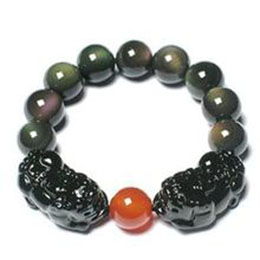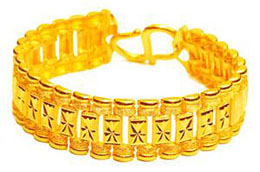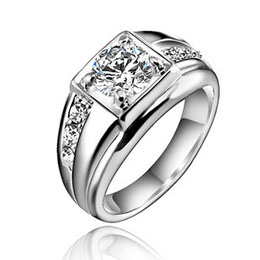A Man’s Guide to Buying Jewelry
The reality is that most of us aren’t that comfortable in jewelry stores.
Between the high price tags and the technical trade language it’s easy to feel out of your depth, whether you’re buying for yourself or a loved one.
Take our quick tips and make your next trip to the jewelry store a painless one:
1. Know What You Want Before Going
Don’t ever walk into a jewelry store and say you’re “looking for something nice for myself/my wife/a friend.”
That’s a great way to get ushered immediately to the most expensive items, and even if the salesperson tries to be genuinely helpful you’re still relying on someone else’s taste, which may or may not match the taste and wardrobe of the person you’re buying from.
Instead, walk in with a clear idea of the basic characteristics you want, even if you don’t have a set of technical terms in mind.
Here is a list of jewelry descriptors you should determine before shopping:

Jewelry Color – Do you want plain gold- or silver-colored jewelry, or are you looking for something with a colored stone? If so, what color? This is your most effective triage, since it automatically eliminates a huge chunk of wrong-colored options.
Specific Metal – Not all silver-tone jewelry is silver, nor is all gold-tone jewelry gold. If you’re set on a specific metal rather than a general color, say so. It helps eliminate a lot of options.
Jewelry Proportions - Don’t be afraid to use unscientific terms here. If you want a slender chain, say so. If you want a big, chunky ring, say that. Give good, descriptive words rather than worrying about technicalities. It’s your job to tell the jeweler “I want a nice set of cufflinks that aren’t too ostentatious”; it’s his job to know what pairs would match that description.
Price – You may not want to mention this up front, but have a limit in your head and stick to it. If you’re offered something above it just say “sorry, that’s more than I was looking to spend” and offer a lower figure. Some jewelers will be willing to haggle over a specific piece’s price, while others will direct you to similar but less-expensive options.
Believe me on this one — you will notice a big difference in going to the jewelers and saying “I’m looking for a moderately-priced gold-colored watch with a narrow band and a plain, modern facing” versus going in and saying “I need a nice watch for work.”

2. Talk to a Jeweler You Trust
Most jewelry purchases aren’t made on the spot. You can do it that way, but it’s better to talk a specific piece over with a friend. If that friend is someone who knows the ins and outs of the jewelry industry, so much the better.
If you aren’t lucky enough to have a good friend who’s also a professional jeweler, ask around the family. You may be surprised who your relatives know — some older men have been dealing with the same family jeweler for decades, and could easily pass on a question or two for you.
When you’re asking for a professional’s second opinion, focus on the things they have expertise in: technical questions, details of quality and weight, origins of stones, etc. You’re trying to fill in the gaps in your own knowledge, not just get an opinion on your taste.
Of course, you may end up wanting to simply purchase from a jeweler you or a family member knows and trusts, and there’s nothing wrong with that. Just be aware that the best second opinions will always come from people with no vested interest in the sale.
3. Know Enough to Ask the Right Questions
Whether you’re dealing with a friendly third party or with the man/woman who’s going to make the final sale, you need to know what questions to ask.
This is where most men get frustrated or intimidated.
Our advice: don’t try to grasp it all at once, and don’t try to pretend you know more than the jeweler — you don’t. Just go in with a solid grasp on the most basic qualities of precious metals and precious gems:
Gold & Precious Metals

Hallmark – This is the manufacturer’s stamp on a precious metal like gold. It should represent either the karat weight (see below) or the purity as a percentage. Percentages are given as three-digit decimals, such that a stamp of “.750″ would indicate 75% pure gold.
Karat weight – A traditional measurement of gold’s purity dating back to before very specific measurements were available. Basically it is a 1-24 scale, with 24 karats theoretically implying pure gold. In practice, anything higher than .999 pure is rated as 24K
Diamonds & Precious Gems
Men buying diamonds in particular are urged to consider “The Four Cs” — carat, cut, color, and clarity. Not all of these apply in quite the same way to other precious stones, but they’re useful terms to know:
Carat – When it’s spelled with a C instead of a K, you’re no longer talking about precious metal. Instead, a carat is a measurement of mass for precious stones, equal to 0.2 grams. People mostly equate this with size, but that’s not necessarily accurate – a good jeweler can cut a diamond (or other stone) to look bigger than a poorly-cut stone of heavier carat weight might. It’s important to know that heavier stones are increasingly rarer, and the price jumps exponentially rather than directly. A 3-carat stone will cost far more than double what a 1.5-carat stone might. Similarly, you can get a good price on stones that came in just under a carat weight: a .9-carat diamond will cost substantially less than a 1-carat.
Cut – This is the measure of quality, not the shape of the stone. In the U.S. precious stone cuts are rated as Ideal, Very Good, Good, Fair, or Poor. This scale was only introduced in 2006, and not all diamonds or other precious stones will.
 Color – Diamonds specifically are rated on a scale from Z to D, with D being a perfectly clear and colorless diamond. Anything J and up is considered high-quality, and accordingly expensive. Color matters more if you’re buying a big stone — it’s not worth spending lots of money for a perfectly colorless diamond if it’s too small for coloring to be noticeable. Some cuts will help make a colored or “clouded” diamond look clearer — this is a good question for the jeweler (or an experienced friend).
Color – Diamonds specifically are rated on a scale from Z to D, with D being a perfectly clear and colorless diamond. Anything J and up is considered high-quality, and accordingly expensive. Color matters more if you’re buying a big stone — it’s not worth spending lots of money for a perfectly colorless diamond if it’s too small for coloring to be noticeable. Some cuts will help make a colored or “clouded” diamond look clearer — this is a good question for the jeweler (or an experienced friend).
Clarity – Diamonds and other stones usually contain imperfections. There are ratings based on how they look to the naked eye and under magnification, but you run into a problem here — depending on where in the stone the imperfections (called “inclusions”) are, they might make the gem look more or less flawed. It’s possible to have two stones of the same cut and the same clarity rating that look quite different to the naked eye. This is one reason to only purchase jewels in person, never online based on the written grading.
4. Find the Right Place to Buy
Not all jewelers are created equal. Some have larger selections, some have better prices; some have more helpful and knowledgeable staff. If you’re very lucky you’ll find one that’s good at all those things, but it can be tough. Know your options:
Big Chains - The “shopping mall” jewelers. You may know some of the names from radio ads: Jared’s, Goodman’s, etc. These focus on the most common types of jewelry: wedding and engagement rings, earrings for women; watches and chains. They tend to have good return policies and other customer service features. The staff may not be as knowledgeable as an independent jeweler, and in some cases be aware that you’ll be dealing with a sales clerk rather than a professional jeweler at first. These are fine places to look for basic jewelry needs, just be sure you’re getting an experienced opinion on the quality, and don’t expect to find anything too out of the ordinary.
Family or Independent Jewelers – Something of a dying breed, most major cities still have a jewelers’ neighborhood. Expect to find a smaller selection with a more eclectic selection of styles than you would at a big chain store. These can be great places to find unusual, eye-catching pieces, and the jeweler will usually have ample knowledge and expertise. On the other hand, returns and exchanges may be more difficult, and there won’t be a fixed catalog to choose from — you’re at the mercy of the jeweler’s selection.
Antique and Pawn Shops – Any second-hand jewelry offers two big opportunities: the chance to score a really unusual piece, and the chance to get majorly ripped off. Exercise caution! If you’re not a jeweler, you’re not really qualified to judge a piece based on its appearance and whatever documentation it might or might not come with. Don’t shell out serious money without a jeweler’s opinion or a really good return policy.
Conclusion: Jewelry Buying for Men
The above four points emphasize knowledge.
That’s because you’ll be more comfortable buying jewelry if you have a little knowledge going in. You don’t need to be an expert (though it helps to know one), but you do need to know — roughly — what you want. It’s the only sure way to avoid buying what a salesperson wants you to have instead.

Comment (0)